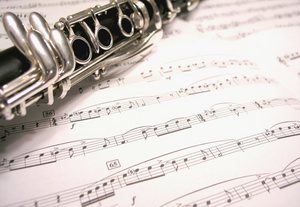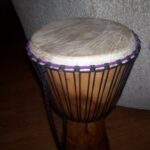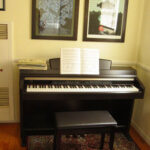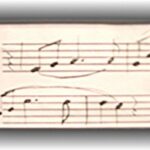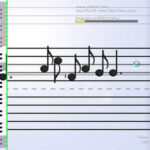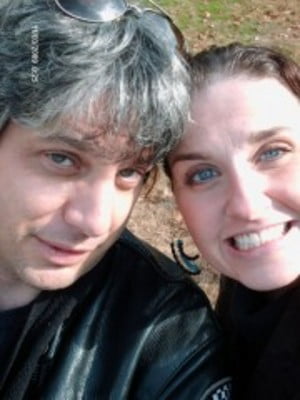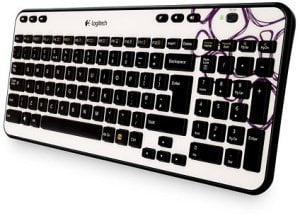Noteworthy Composer is by far the best MIDI creation software I have ever used. It comes with instrument and rhythm templates, and permits you to create your own templates. It’s very intuitive and uses traditional musical notation. I use the program extensively to create music for my videos. You don’t need to know a great deal about music to use the program. However, you need to know a few tricks to get it to really do what you want.
Getting Started
I strongly recommend that you work from sheet music to begin with. It’s fairly simple, albeit rather time consuming, to enter sheet music directly from the original into Noteworthy Composer. If you download sheet music from the web, print it out. If you wrote the song yourself, write it down or print it out before you begin. This will save you an enormous amount of time, pain and effort working with Noteworthy Composer.
When you first open the program you will see a blank grey screen. Simply select the page icon, or select File > New from the menu to get started. Immediately the Song Templates window opens. Select the template which you want. A blank score option is available, but if you’re just getting started, it’s best not to start out completely from scratch. I generally use the Piano template, which I think sounds the best by far. There is also a Quartet template, an SATB template, and a VocalACC template. Two tabs behind this allow you to create your own custom template, or to select a rhythm template.
You may fill in the fields in the next dialogue box if you like. Or you can always go back later to fill them in.
Key Signatures and Time Signatures
Now you will see a basic treble clef and bass clef. The first things you need to add are the key signature and the time signature. There are several different ways to add these signatures to your MIDI file. First, you may select Insert > Key Signature and Insert > Time Signature from the menu. You can also select them from the toolbar directly above the workspace. A number of different time signatures, for example, are clearly displayed in the toolbar. Simply copy what’s on the sheet music. The key signature button is right next to this.
You may also click the right mouse button in order to add these signatures. First select the Notation option, then choose the signature you need. There are also a number of keyboard shortcuts available if you find selecting menus is too time consuming. The shortcuts for Key Signature are K,k and the shortcuts for Time Signature are G,g.
The time signature is simple enough, but you may struggle with entering the key signature if you’re not familiar with them. To find out which key signature your piece uses, look at Espie Estrella’s Key Signature page on About.com. It has an list of key signatures which will enable you to enter your key signature in one quick step. You only have to count the number of flats or sharps to know which key signature you’re using. There’s no need to map their placement. If your sheet music shows no flats or sharps, select C Major as your key signature. You may also enter your key signature manually. Simply leave User Defined selected, and then select the radio buttons to make the notes sharp, flat, or natural.
Tempo
To choose the tempo, select Insert > Tempo from the menu. Don’t worry if you get it wrong. You can always change it later. Noteworthy Composer uses a numerical tempo, so you’ll have to guess. If the tempo on your sheet music says, Allegro Agitato, for example, the piece should be played extremely fast. If you become confused at any time about Italian musical terminology, simply select Help > Contents from the menu and search on the term. There is a full list of musical terms in the Noteworthy Composer help file which will explain to you what each term means. If there are any terms missing from the help file, you can most likely research them on the Essentials of Music Glossary site. This site has a very thorough list of music terms, along with definitions and Real Audio sound files to help you to understand exactly what the terms represent. http://www.essentialsofmusic.com/glossary/glossary.html
Dynamics
The volume of the score is determined first by the dynamics of pianissimo through fortissimo which are entered before the first notes are played. These dynamics can be accessed through the Insert > Dynamic command, right clicking and selecting Notation > Dynamic, or selecting D,d from the keyboard. Probably the easiest way is through the toolbar, where the abbreviations for the notations can be clearly seen.
It’s important to understand how Noteworthy Composer deals with dynamics before you start simply transcribing sheet music exactly into the program. Noteworthy Composer has a very mechanical understanding of dynamics. To Noteworthy Composer, pianissimo is an exact decibel value, not a relative value. So it will always approach the dynamic the same way. In my experience, pianissimo is always far too soft on Noteworthy Composer, and in my notation I have almost always had to go with something louder. So after entering your dynamics, always be sure to listen to the file before committing yourself. You may find it needs some adjustment. Also, in Noteworthy Composer, dynamics are by staff. Usually, when a dynamic is added to one staff, the other staff takes on the same dynamic by default. However, I’ve found in some cases this doesn’t work. So in order to ensure that the piece plays properly, it’s best to add the same dynamic to both staffs. Also, you may assign a different dynamic to each staff. This function is also helpful if a change in dynamic occurs at a different place on one staff than on another.
Dynamic Variance
Volume Control
The next way to control the volume is through the Staff Properties. This enables you to set a volume for the whole staff without having to change your dynamics. These can be accessed by selecting Edit > Properties from the menu, or right clicking on the staff and selecting Staff Properties. Select the MIDI tab. Here you will see several fields. At the top, you will see Part Volume along with a number. The default is the maximum volume, which is 127.
If you enter your piece into the computer, and you find that one staff is overwhelming another, you can adjust this volume value. For example, when I recently entered Chopin’s Fantaisie Impromptu into Noteworthy Composer, I found that the left hand of the piano was so loud that you couldn’t hear the melody properly. So I left the right hand, or treble (upper) staff Part Volume at 127, but reduced the left hand or bass (lower) staff to around 100. I had to play around with this to make sure it was right. I ultimately decided on 90 as a good value for the left hand, since at 100 it was still overwhelming the melody.
Staves
You can add a new staff to the score at any time by selecting Staff > New Staff from the menu. Staves default to the bottom of the score. You can move them easily by selecting the Move Staff commands from the staff menu.
You can play back only one staff by pressing Shift F5 on your keyboard. You can also mute individual staves in order to hear select staves in playback.
Transpose Staff Command
This is used to visually transpose the notes on a staff. The key signature of the piece will be changed accordingly. This feature can be set up so that it doesn’t affect the sound of MIDI playback. Set these properties in MIDI tab of the Staff Properties dialog box.
Note Entry
To begin entering the notes, select the type of note you need. The notes are available in the toolbar, and there are also keyboard shortcuts. These shortcuts are all numbers, and can be easily accessed from the number pad of your keyboard.
1 – Whole Note
2 – Half Note
3 – Quarter Note
4 – Eighth Note
5 – Sixteenth Note
6 – Thirty-second Note
You can also use the keyboard to select certain signs for your entry in the number pad.
7 – Natural Sign
8 – Flat Sign
9 – Sharp Sign
You may also select the period key to assign the dotted note status to your note entry.
For a complete list of keyboard shortcuts, search on “Keyboard Shortcut” in the Noteworthy Composer help file.
When you select the type of note you need, use the arrow keys to select the proper placement on the staff, then press Enter. To add a note to a chord, select Ctrl + Enter. To remove a note from a chord, select Backspace + Enter. You must be on the staff line of the note in question for this removal method to work.
In order to add a natural, flat or sharp sign, or other special attribute to your chord member, you must select the attribute in the toolbar before creating the note. You cannot go back and add the attribute afterward without adding the same attribute to all the other notes.
Moving Notes
If you have placed your notes on the staff in the wrong place, you can move them. Simply select the notes in question, then press Ctrl Shift and the up or down arrows on the keyboard. This will move the selected notes up or down on the staff.
Chords
Noteworthy Composer has certain limitations in how it can create chords. Generally you can join as many notes together as you like, as long as they are of the same value. However, if the notes are of different values there are only certain things you can do.
You may have a note of one value on top, and a note of a different value on bottom. However, you cannot intersperse the notes of different values. For example, if a score calls for a quarter note on middle c, a half note on g and a quarter note an octave above middle c, Noteworthy Composer will not allow you to enter all the notes as written. You can enter the middle c and the g, or the g and the high c, but not all three. The notes will also have the duration of the shortest note, in this case a quarter note.
For this reason, you may need to change arrangements when you enter them into Noteworthy Composer. For example, I have had to make some alterations to the first movement of Beethoven’s Moonlight Sonata. In the thirty-first bar, there was a whole note chord, along with the melody line, beginning with an eighth rest, all on the bass clef with no rest on the upper staff. I solved this problem by simply leaving the whole note chord on the bass clef, and moving the melody line up to the treble clef.
Other problems can be solved by creating a new staff, and assigning it the same instrument patch as the original staff.
Persistent Note Tools
By selecting the Persistent Note Tools button from the toolbar, you can cause a parameter such as the dotted note parameter to remain on until you turn it off. This is extremely useful if you have a whole series of dotted notes, flats, or sharps to enter in a row.
Bar Lines
Bar lines can be easily added by typing the tab key, or the asterisk key on the number pad.
If there’s a special property you need to assign to your bar line, such as repeat, you must select the bar line and select Properties from the right click menu. Then you can assign one of the following properties to your bar line:
Single
Double
Section Open
Section Close
Local Repeat Open
Local Repeat Close
Master Repeat Open
Master Repeat Close
Refer to your score to see which one of these features you need. For example, local repeat close is rendered as a light double line with two dots on the left side. Local repeat open has the dots on the right side. Master repeat uses the same notation with a heavy line. Section open has a heavy line with a light line, and section close has the same lines in the reverse direction.
Local repeat allows a section to be repeated a specific number of times. Master repeat is similar, except it requires that a number of different endings be used. Once you have created your master repeat close, you may assign up to seven endings by selecting the special endings button from the toolbar, or pressing “s” on the keyboard.
Triplets
In music, we often see three notes which take the space of one beat. This is called a triplet. So if you see three notes joined with a three by the beam, or six notes joined with a six by the beam, you will need to alter them accordingly in Noteworthy Composer.
In order to create a triplet or sextuplet, you may simply select the notes in question, and then select the Triplet button from the toolbar. The Triplet command is also available in the right-click menu, and from the Edit menu.
In order for the Triplet command to work, the notes must be a valid triplet. All notes must be of the same duration, and must be a multiple of three.
I ran into one problem when I was entering Fantaisie Impromptu. There was one sextuplet in the piece. There was physically no way to transcribe this into Noteworthy Composer. I ultimately decided to join the first six notes as a Triplet (sextuplet) and omit the last note. At times, you may have to make compromises like this when Noteworthy Composer can’t do what the composer wrote. However, for most musical pieces, Noteworthy Composer’s tools are more than adequate.
Beams
To make your musical score neater and easier to read, you can beam the notes. To beam notes, simply select the notes and then select the Beam button from the toolbar. The Beam command is also available from the right-click menu, and from the Edit menu.
You may beam notes which are of different durations. You may also change the direction of the stem. The Stem Up and Stem Down commands are easily accessible from the toolbar. They show a note with a red arrow pointing up, and another note with a red arrow pointing down. The Stem Up and Stem Down commands are also available from the right-click menu, and the Notes menu.
Pedal
The pedal notation in Noteworthy Composer looks the same as in regular musical notation. However, it functions differently. Usually, when you apply pedal to only one staff, all staffs default to this pedal. However, the moment you place a pedal on another staff, Noteworthy Composer treats the pedal on each staff separately. If you fail to release the pedal on that specific staff, you’ll find that your score is a muddle. The notes sustain long after they should have ended because the pedal was never released on the staff in question.
Another idiosyncrasy of Noteworthy Composer is that pedal and pedal release must be placed amongst the notes. For this reason, when a whole note rests on a measure, only one pedal and pedal release can be used on that staff. If you want a more complex pedal arrangement, you must place the pedal on a different staff.
If you have just played a score in which the pedal was down at the end, and begin to replay the score, play another one, the pedal will continue to be in effect. If this happens, click the stop button twice.
Converting MIDI to NWC
While Noteworthy Composer has the ability to convert MIDI files to NWC format, I have found this conversion tool to be dysfunctional. There is no information in the help file about how to use the conversion tool, and the files usually come out looking and sounding like a huge mess. I recommend avoiding this tool. If you need to work directly with MIDI files, there is an excellent free tool on the web called Anvil Studio which is very effective and easy to use.
However, converting NWC to MIDI is very simple. Just select Save As and select *.mid as your file type.
Lyrics
Noteworthy Composer now supports lyrics. Lyrics can be added by pressing the “L” button in the toolbar, or by pressing Ctrl L on the keyboard. Use a hyphen to separate syllables within a word, a space to separate words, one carriage return to begin a new phrase, and two carriage returns to begin a new paragraph or verse. If you want to skip a note, use the underscore symbol for each note skipped. Also, you can select notes you don’t want to have lyrics, press Ctrl E or Alt Enter, and set the Lyric Syllable to Never.
MIDI Channels
Each staff in Noteworthy Composer must have its own channel. Each staff is assigned a different channel by default in Noteworthy Composer, but if different staves use the same instrument, they can probably share a channel. I have used the default channels in all of my musical transcription, and have never had a problem.
However, if you encounter a problem, it’s probably because you have different staves which have been assigned different instruments but are on the same channel. Right click the staff, and select Staff Properties to see which channel has been assigned to each staff and make corrections.
Also you will need to alter the channel of a staff in order to use percussion in your piece. I once copied and pasted a percussion section into another piece, only to discover that it didn’t play as percussion. I changed the MIDI channel to 10 on the new staff, and the section played as percussion again. Many sound cards use MIDI channel 10 for percussion, but others use channel 16.
Using Noteworthy Composer with a MIDI Keyboard
In order to use Noteworthy Composer with a MIDI keyboard, your sound card must support MIDI, and have a MIDI interface. If you’re using the onboard sound card that comes with your motherboard, you will not be able to use a MIDI keyboard. This means you’ll have to invest in a new sound card. If you do a lot of transcribing, this is probably a sound investment, since it will save you an enormous amount of time on note entry.
Once your MIDI keyboard is properly connected to your computer, just select the record button from the toolbar, and begin playing. If you want to record notes at your own pace, rather than in real time, then select Tools > Options from the menu. Click the record tab, and make sure the Input Device Driver for your system is selected. Click the MIDI tab, and set MIDI Port Usage to While Active or Always. Then select Tools > MIDI Input Active from the menu. Now you can record notes in step time, at your own pace. The pitch bend wheel can be used to set the note duration prior to note entry.
The Noteworthy Composer Scriptorium
The Noteworthy Composer Scriptorium is an excellent place to find NWC and MIDI files, and tips and tricks for Noteworthy Composer. You can also find templates, sound fonts, macros, and other helpful files. There are tutorials on how to use Noteworthy Composer on Linux, how to convert between NWC and ABC format, and links to MIDI utilities. You can find various soundfonts, which are instrument patches which can be uploaded to your sound card, if it’s compatible.
In Noteworthy Composer, Dynamic Variance is a separate function from Dynamics. You will use Dynamic Variance to add changes in dynamic such as crescendo, decrescendo, diminuendo and so on. However, these dynamic variations do not work as stand-alone functions in Noteworthy Composer. In order to make crescendo and decrescendo work in Noteworthy Composer, you must have the beginning dynamic placed before the variance, and the ending dynamic after the variance. For example, say that my present dynamic is mezzo forte, and I want the piece to decrescendo to mezzo piano. In order to accomplish this, I must place “mf” before the dynamic variance entry “decresc.” Then I must place the “mp” somewhere on the staff after the dynamic variance entry.
It’s extremely important to strategically place the dynamics far enough away from the variance entry to get the gradual increase or decrease in volume that is desired. If the dynamic value is placed too close to the variance entry, the volume will change too quickly, and the piece won’t sound right. Be sure to listen to your piece several times at least, and adjust the placement until the desired sound is achieved.
